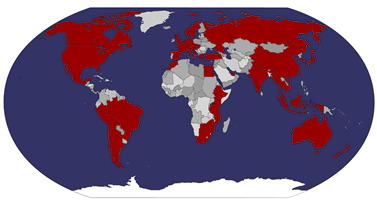After waking up the security guards again, this time to get out (at the late hour of just before 7am), I walk down to the café next to the Telcom building,where I meet Ron for breakfast. He’s having “Full”, and I’m not in the mood for it, tea will do me. Tea here they make in a strange way – bringing you a tea-bag and a cup of hot water into which has had cinnamon infused.
The taxi to the airport takes longer than I remember, and we arrive about an hour before the flight. Not an issue though, as the flight is of course late. We’d been told to check-in early but there’s no sign of much happening. After check-in, the bags are left by the empty check-in desks and a sign saying do not leave bags! I check out the postcards, they all look like they were printed in the 70s, nice faded pastel colours and dodgy haircuts. Our departure time comes and goes, it’s very peaceful! The plane comes late, but comes at least!
We take off, and the scenery is beautiful, like an African Grand Canyon.

I wonder how the rocks were cut – we fly over the Simiens, including Ras Dashen (4543m).

One can see small settlements dotted here and there, with small round huts surrounded by stone walls.

We’re served crackers and soft drinks, before landing at Lalibela. Ron alights, and I carry on to Axum. More crackers.

Hydro-electric dam
An elderly English woman says to me as we disembark “You look like you’re going to do this the hard way?” to which I respond “Oh I don’t know, I like some occasional comfort!”.
After a 20 birr shared taxi into town, I’m dropped at Hotel Abinet, where I find a nice room for 60 birr a night. Down at their restaurant, which is supposed to be one of the best in town (what a coincidence I’m staying here), I order some kind of tuna dish, which to my horror turns out to be a SALAD! Help! Salad in Ethiopia? Vegetables washed in tap water that even the locals don’t seem to drink, an assumption based on the large amounts of mineral water every shop seems to stock. Ah well, you only live once – I eat it up, then head back upstairs, forgetting my camera, how careless!

Get some washing done, everything is so dusty. I leave the washing drying on the balcony, and head out, walking along the road to the other end of town, where most of the good stuff is.


The Northern Stelae Field
At the St. Mary of Zion Church, I find out that I can’t get the ticket one needs for all attractions here – I have to go to one of the Tourist Agencies. LP recommend Tigris, but I can’t find the place, so I end up in another anonymous place. Takes a while to find a person sitting in an unmarked office in the corner who writes out a ticket I can’t read for 50 birr.
Axum – the Centre of the Axumite Empire
So why am I here? Axum, right at the top of Ethiopia, in the NW Tigray highlands at 2130m and close to the disputed Eritrean border, twinned with Denver in the US (?!!), is named after the Kingdom of Axum, a large empire stretching right into the Middle East, growing up 500 years after decline of nearby Yeha, from 400BC to the 10th century. As a Christian Empire, it declined as its trade routes to Alexandria, Byzantium and the Mediterranean were cut off by the rise of Islam. The town was also the home of the Queen of Sheba and the centre of her dynasty, plus supposedly hosts the original Ark of the Covenant.
Back near the church, there are guides and beggars everywhere which I ignore, heading in. Here I have to get an extra ticket for another 60 birr. The guy hands one over without writing it out on the pad in front of me, so I refuse it and ask for another. The St. Mary of Zion Church is the most holy site in Ethiopia.


Fancy lightening conductor
Supposedly, Muslims wanting to build a mosque here were told that they could as long as the Orthodox Church could erect a church in Mecca. Of course, non-Muslims are not even allowed to go to Mecca, something of which the Islamic church should be ashamed – at least all the other major religions let non-believers visit their holy sites. The main church was supposedly opened by Queen Elizabeth. It’s a big domed building, inside it’s quite bare, but the floor is filthy - a bit cheeky given that we have to take our shoes off.

There are pigeons perched on paintings dropping their feathers.

I walk round, admiring the artwork.



Look from further away… spooky!


Next over to the old church, dating from the 1665, and built by Emperor Fasiladas on the site of an Axumite 4th century church.

For some reason women are not allowed here. I find it amusing, all this women not being allowed stuff – why on earth not? Presumably a rule dating from the time the church was established – come on guys, it’s not like there are innocent monks living here who might be corrupted! To the left as we approach the church is the building housing the Ark of the Covenant,

which we’re not allowed to approach – supposedly if you get too close, you burst into flames! What is the Ark of the Covenant? It’s supposed to be a box with various goodies, including the original stones with the ten commandments written on them. A guard with a gun makes sure we’re not put at risk. The old church inside is the standard set of pictures of biblical scenes, which are beginning to bore by now – why am I going to Lalibela next?!!


I stroll through the garden behind the church.



Defenders of the faith
There are eagles perched up on the roof



Exiting the church I pass the line of beggars yet again, then head over the road to the Northern Stelae Field.

Looking back to St. Mary of Zion over a broken stela
What is a Stela?

Apparently it’s a large hunk of rock like an obelisk, but not so geometrically symmetrical. These are the iconic monuments of Axum. There are lots of them all over town, but seven particularly impressive monolithic stelae, hewn from single pieces of granite, weighing in some cases over 500 tonnes, and 20m high. Several of them are broken and lie on the ground.

Interestingly, when Italy invaded during the second world war, they pinched one of the better ones (24m, 1,700 years old), took it back to Italy, where it remained until 2005. It was a source of diplomatic tension, with Ethiopia campaigning for the return of what they saw as part of their national heritage, a la Elgin Marbles (embarrassing factoid – until I saw them in the British Museum, I assumed the Elgin Marbles were, errr, marbles.. [he goes red] – large impressive ones of some kind of course, but still, well, round stones of some kind that you could trade with other people with very large round stones!). Anyway!

Eventually Italy returned this stela, even paying the shipping costs of 4 million US$ (how did it end up costing that much, I don’t know). So back in Axum and Ethiopia, much joy and celebrations. So ten years later, have they erected it? Is it on show? Err, no. They’ve done nothing with it. Don’t return the Elgin Marbles, England!
There is also supposed to be lots underground, most of which has not been explored yet.

Access to underground tombs
King Bazen’s Tomb manifests itself as a dark stone staircase into the ground. Apparently he was the king here at the time of birth of Christ. In reality, a dusty hole in the ground with lots of small flies or (gulp) fleas. Out we go.
Ethiopian Domestic Flight Summary
Ethiopian Airlines are described as very cheap in guidebooks, but just recently they’ve been bumping the prices up (think double what 2007 guides say) so that it’s not so good value. In particular, a few days ago they whacked a fuel surcharge of about 10US$ on top of all the existing fares. It’s a shame, as the buses are horribly long so one needs to fly really – it’s 2.5 days from Addis to Axum!
You can pay with credit cards in Addis Ababa and Bahir Dar, but not in Gonder, Axum and Lalibela, cash only at these offices. There is no good reason for this extremely inconvenient inconsistency.
They do a daily loop from Addis to Bahir, Gonder, Lalibela, Axum and back again. In general it seems you need to book two days before to be sure of a seat.
Prices in Birr after the rate hike:
Addis – Bahir Dar 1098
Bahir Dar – Gonder 447
Gonder – Lalibela 708
Lalibela – Axum 870
Axum – Addis 1854
Axum – Mekele (W/F only) 489
Incidentally, I missed a trick with these domestic flights – if one flies into the country with Ethiopian Air (which I did), there is some sort of special offer where you get a package of the domestic flights taking you round the northern historical circuit for a set price which is substantially cheaper than if you buy them individually – one couple I spoke to said it cost them about 200 euros, probably about half what I’ve paid in total. I’ve been told also that you can only get this deal if there are two or more people travelling.
In the evening, I watch the movie Blood Diamond. It does represent some of the problems Africa faces quite well. Then down for dinner, where I order meat with injera. It comes as the usual tasty spicy sauce with several pieces of sheep which have the occasional pocket of meat in between bones and fat. It’s difficult not to get oil everywhere. As I eat, I read the history section of my Africa LP. Later, up at the bar, I watch the Nigera Ghana semi-final, accompanied with a St. George beer or three. Nigera should have gone through, what were they thinking?




No comments:
Post a Comment